Understanding the Functionality of a Rotary Hammer Drill

A rotary hammer drill is a versatile power tool that is commonly used in construction and renovation projects. It is specifically designed to drill into hard materials such as concrete, stone, and masonry. The drill is powered by an electric motor, which rotates a bit that is equipped with a hammer-like mechanism. This unique design enables the drill to provide both rotating and hammering action simultaneously, making it more efficient and effective than traditional drills.
One of the key features of a rotary hammer drill is its ability to deliver a high impact force, which is essential for drilling through tough materials. The hammer-like mechanism inside the drill delivers rapid blows to the bit, allowing it to easily penetrate through hard surfaces. This makes the rotary hammer drill an ideal choice for tasks such as drilling holes for anchor bolts, installing electrical conduits, or breaking up concrete for demolition purposes.
In addition to its drilling capabilities, a rotary hammer drill can also be used for chiseling and demolition work. By simply switching the drill bit for a chisel attachment, the tool can be transformed into a powerful hammer that can chip away at concrete or break up tile. This versatility makes the rotary hammer drill a valuable tool for contractors and DIY enthusiasts alike.
When using a rotary hammer drill, it is important to wear the proper safety gear, such as goggles and ear protection, as the tool can create a significant amount of noise and debris. It is also important to use the correct drill bits and attachments for the specific task at hand, as using the wrong tool can result in damage to the drill or injury to the user. By understanding the functionality of a rotary hammer drill and following proper safety guidelines, users can harness the power of this tool to complete a wide range of construction and renovation projects.
What is a Rotary Hammer Drill?
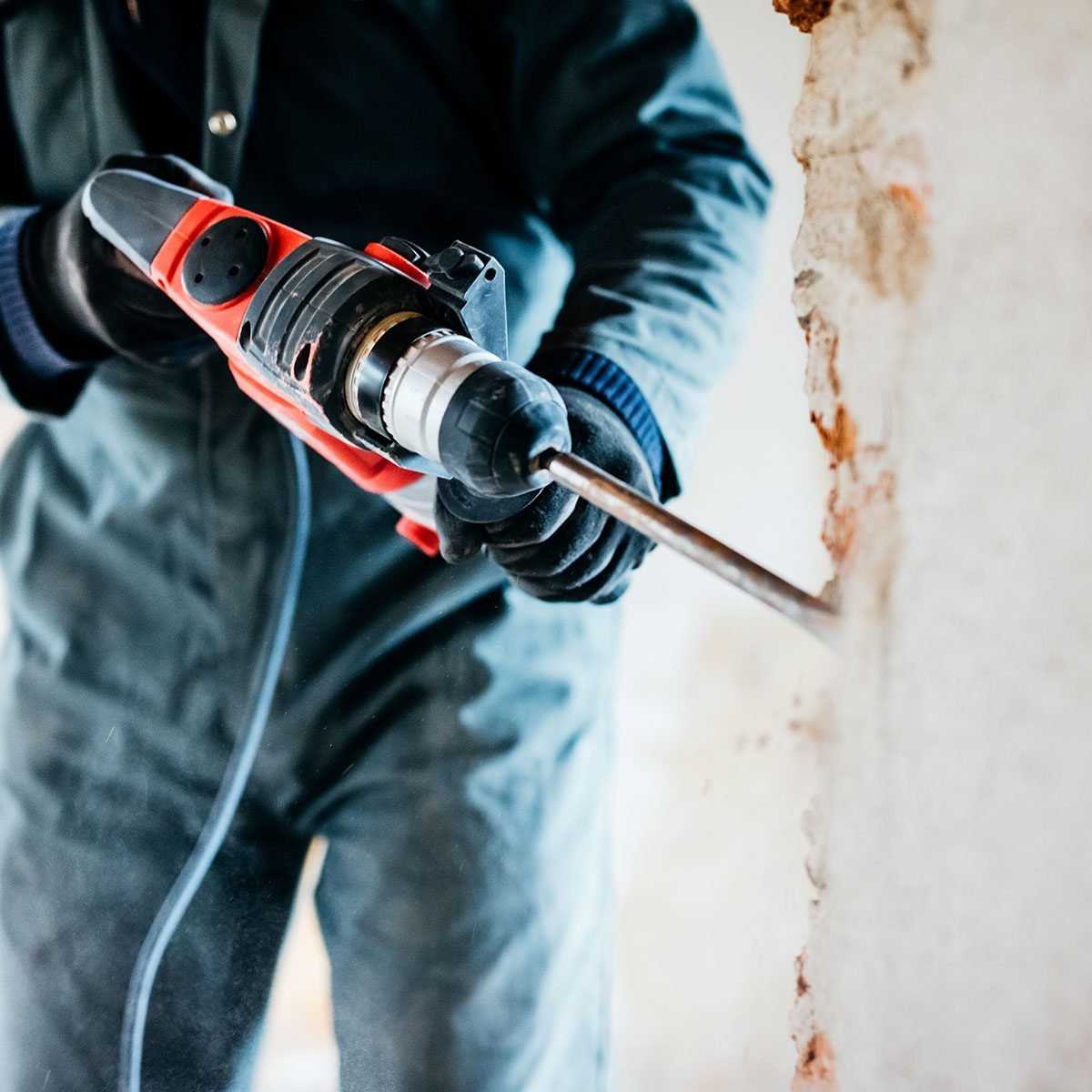
A rotary hammer drill, also known as a roto hammer or a hammer drill, is a powerful hand tool used for drilling holes in hard materials such as concrete, masonry, and stone. It is widely used in construction and renovation projects where traditional drills are not capable of drilling through tough surfaces.
The main difference between a rotary hammer drill and a regular drill is the addition of a hammering action. While a regular drill applies rotational force to drill into materials, a rotary hammer drill combines both a rotating motion and a forward hammering motion to create a more powerful impact. This allows the drill to effortlessly break through hard materials without applying excessive force or causing damage.
Features of a Rotary Hammer Drill:
- Hammering Action: The hammering action of a rotary hammer drill is achieved through a piston mechanism that strikes the back of the drill bit as it rotates. This hammering action helps to break up the material being drilled and facilitates faster drilling.
- Variable Speed: Most rotary hammer drills come with variable speed settings, allowing users to adjust the drilling speed according to the type of material being drilled and the desired outcome. This feature provides greater control and precision during drilling.
- Chisel Function: Many rotary hammer drills also have a chisel function, which allows them to be used for chiseling and breaking up materials. This makes them versatile tools that can handle a variety of tasks.
- Power Source: Rotary hammer drills can be powered by electricity or batteries. Electric rotary hammer drills are generally more powerful and suitable for heavy-duty applications, while battery-powered ones offer greater portability for jobs that require mobility.
Applications of a Rotary Hammer Drill:
Rotary hammer drills are specifically designed for tasks that involve drilling into hard materials. They are commonly used in construction projects for tasks such as:
- Drilling holes for anchor bolts or screws in concrete or masonry walls.
- Installing electrical fixtures and outlets in concrete or brick surfaces.
- Creating holes for pipes and conduits in walls or floors.
- Demolition work, such as breaking up concrete or removing tiles.
Overall, a rotary hammer drill is an essential tool for any construction or renovation project that involves drilling into hard materials. Its ability to combine rotary and hammering motions makes it a powerful and efficient tool, saving time and effort for professionals and DIY enthusiasts alike.
Exploring the Key Features
1. Power and Performance
The key feature of a rotary hammer drill is its power and performance. These drills are specifically designed to provide high impact energy, allowing them to easily break through tough materials like concrete, stone, and masonry. With their powerful motors and specialized mechanisms, rotary hammer drills can generate the necessary force required for heavy-duty drilling and chiseling tasks.
2. Hammering and Drilling Modes
Another important feature of a rotary hammer drill is its ability to switch between hammering and drilling modes. The hammering mode is used for tasks that require chiseling or breaking through tough materials, while the drilling mode is used for standard drilling tasks. This versatility makes rotary hammer drills suitable for a wide range of applications, including construction, renovation, and DIY projects.
3. Vibration Control
Rotary hammer drills often come with built-in vibration control features. These features help to reduce the amount of vibration transferred to the user during operation, providing a more comfortable and stable drilling experience. This is especially important when using the drill for extended periods of time or when working on large-scale projects. Vibration control also helps to minimize fatigue and potential injuries caused by excessive vibrations.
4. Depth Gauge
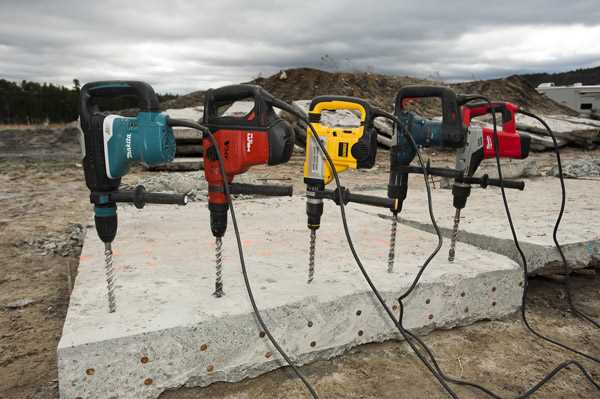
Many rotary hammer drills include a depth gauge feature. This allows the user to accurately control the depth of the drilling or chiseling operation. By setting the desired drilling depth, you can ensure precise and consistent results, especially when working on projects that require specific hole depths. The depth gauge also helps to prevent accidental over-drilling or going beyond the required depth.
5. Forward and Reverse Operation
Rotary hammer drills often have a forward and reverse operation feature. This allows you to easily remove the drill bit from the material by switching to the reverse mode. It also enables you to remove screws or other fasteners that may be threaded in the opposite direction. This feature adds convenience and efficiency to your drilling tasks, saving you time and effort.
6. Variable Speed Control
Variable speed control is another notable feature of many rotary hammer drills. This feature allows you to adjust the speed of the drill to match the requirements of the task at hand. By controlling the drilling speed, you can achieve better precision and avoid damaging the material. It also gives you the flexibility to work with different materials that may require varying speeds for optimal results.
7. Additional Accessories and Attachments
Many rotary hammer drills come with additional accessories and attachments that enhance their functionality. These may include different types and sizes of drill bits, chisels, and depth stoppers. Having these accessories readily available allows you to tackle a wider range of drilling and chiseling tasks without the need for separate tools. It also adds value to your rotary hammer drill investment.
8. Durability and Construction
Rotary hammer drills are designed to withstand heavy use and tough working conditions. They are constructed with durable materials and robust components to ensure long-lasting performance. The housing and handles are often made from impact-resistant materials to protect the drill from accidental drops or impacts. Additionally, the internal mechanisms are engineered to handle the high forces generated during drilling and chiseling operations.
9. Safety Features
Modern rotary hammer drills are equipped with various safety features to protect the user during operation. These may include features such as overload protection, which automatically shuts off the drill if it becomes overheated or overloaded. Some drills also have a clutch mechanism that disengages the rotation of the drill bit if it jams or encounters excessive resistance. These safety features help prevent accidents and injuries while using the rotary hammer drill.
Differences from Regular Drills
A rotary hammer drill differs from a regular drill in several key ways:
- Impact Mechanism: The most notable difference is the presence of an impact mechanism in a rotary hammer drill. This mechanism allows the drill to generate a powerful forward and backward hammering motion, in addition to the rotational motion of a regular drill. This combination of motions allows the rotary hammer drill to easily break through tough materials such as concrete and masonry.
- Chuck Type: Rotary hammer drills typically have a different chuck type compared to regular drills. While regular drills often use a keyless chuck or a traditional chuck that requires a key to tighten and loosen the drill bit, rotary hammer drills often use a SDS chuck or a similar mechanism. This type of chuck allows for quick and easy bit changes, minimizing downtime during a project.
- Size and Weight: Due to the additional components required for the impact mechanism, rotary hammer drills are typically larger and heavier than regular drills. This increased size and weight may make the rotary hammer drill more challenging to maneuver and control, especially for extended periods of use.
- Power: Rotary hammer drills generally have more power compared to regular drills. This increased power allows the rotary hammer drill to effectively penetrate hard materials with less effort, making it ideal for heavy-duty applications.
- Usage: While regular drills are versatile and can be used for a wide range of applications, rotary hammer drills are specifically designed for drilling into hard materials such as concrete, brick, and stone. Their robust construction and capabilities make them a preferred choice for professionals in construction and remodeling industries.
In summary, a rotary hammer drill differs from a regular drill in terms of its impact mechanism, chuck type, size and weight, power, and usage. These differences make the rotary hammer drill a more suitable tool for heavy-duty drilling tasks requiring the penetration of hard materials.
Understanding the Working Mechanism
A rotary hammer drill is a powerful tool that is specifically designed for drilling into hard materials such as concrete, stone, and masonry. Unlike a regular drill, which uses a rotating motion to create holes, a rotary hammer drill combines both a rotating and a hammering action to provide a more effective drilling performance.
1. Hammer Mechanism
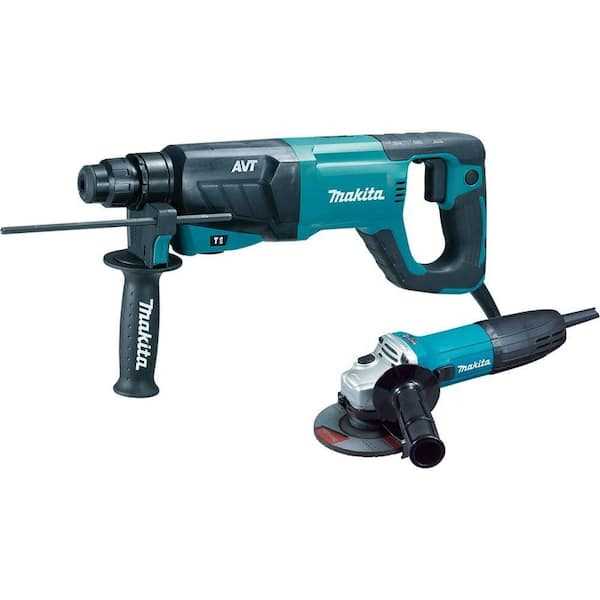
The main feature that sets a rotary hammer drill apart from a regular drill is its hammer mechanism. Instead of relying solely on the spinning motion of the bit to create holes, a rotary hammer drill uses a piston mechanism to deliver a powerful hammering action. This mechanism is usually driven by a high-torque motor, which generates the necessary force for the hammering action.
2. Impact Energy
The effectiveness of a rotary hammer drill is measured by its impact energy, which is the amount of force delivered to the material being drilled. This impact energy is determined by factors such as the power of the motor, the weight of the hammer mechanism, and the design of the bit. The higher the impact energy, the easier it is for the drill to penetrate hard materials.
3. Rotation Speed
In addition to the hammering action, a rotary hammer drill also has a rotating motion that helps to remove the debris from the hole. The rotation speed of the drill can be adjusted to suit different drilling tasks. For example, a slow speed is ideal for drilling into hard materials, while a higher speed is suitable for drilling into softer materials.
4. SDS System
Rotary hammer drills often use a special chuck system called the SDS system. This system allows for quick and easy bit changes, as well as improved power transmission between the drill and the bit. The SDS system reduces the chance of the bit slipping or falling out during use, improving both safety and productivity.
5. Additional Features
Some rotary hammer drills come with additional features that enhance their functionality and usability. These features may include a variable speed control, a depth stop, a built-in dust extraction system, and a vibration reduction mechanism. These features make the drill more versatile and user-friendly, allowing for greater control and precision.
| Component | Description |
|---|---|
| Motor | Provides the power for the hammering and rotating actions. |
| Hammer Mechanism | Delivers the hammering action that helps to penetrate hard materials. |
| Chuck | Holds the drill bit securely in place. |
| Handle | Allows for a comfortable and secure grip on the drill. |
| Depth Stop | Controls the depth of the hole being drilled. |
The Importance of Hammering Action
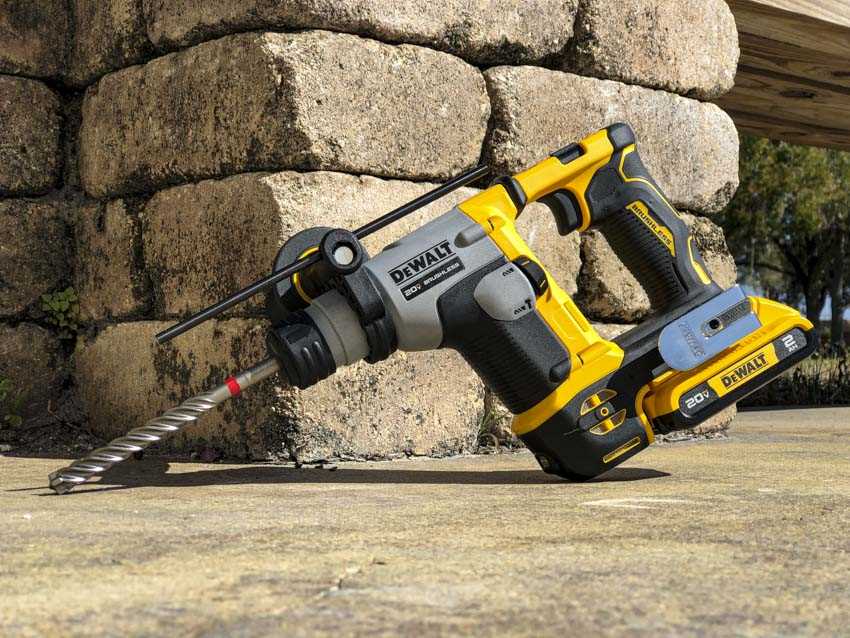
One of the key features of a rotary hammer drill is its hammering action. This feature sets it apart from regular drills and makes it an essential tool for certain applications.
What is Hammering Action?
Hammering action is a specialized mechanism present in rotary hammer drills that enables them to deliver powerful and rapid blows. This mechanism combines both rotary motion and striking force, allowing the drill bit to chip away at tough materials such as concrete, masonry, and stone.
The hammering action is achieved through a piston mechanism inside the drill, which rapidly moves back and forth, striking the back of the drill bit. This rapid impact creates a hammering effect that helps break through the hard surface.
The Benefits of Hammering Action
The hammering action in a rotary hammer drill offers several benefits:
- Increased Efficiency: The hammering action allows the drill bit to penetrate tough surfaces with ease, reducing the time and effort required to complete a task.
- Enhanced Drilling Performance: Regular drills often struggle to drill through hard materials, resulting in slower drilling speeds and decreased accuracy. The hammering action of a rotary hammer drill eliminates these issues and ensures precise drilling even in the toughest of materials.
- Versatility: With the ability to switch between drilling-only mode and hammering/drilling mode, rotary hammer drills offer versatility in tackling various projects. The hammering action makes them suitable for tasks such as installing anchors, demolishing concrete, and drilling into masonry.
Considerations
While the hammering action of a rotary hammer drill is powerful and effective, it also creates a significant amount of noise and vibration. It is important to wear appropriate personal protective equipment, such as ear protection and gloves, when operating a rotary hammer drill to minimize the potential risks.
Additionally, it is crucial to select the right type of drill bit for the specific task at hand. Different drill bits are designed for different materials, and using the wrong bit can result in reduced drilling efficiency or damage to the tool.
| Material | Recommended Drill Bit |
|---|---|
| Concrete | Carbide-tipped masonry drill bit |
| Masonry | Carbide-tipped masonry drill bit |
| Brick | Carbide-tipped masonry drill bit |
| Stone | Diamond-tipped drill bit |
In conclusion, the hammering action of a rotary hammer drill is an indispensable feature that enables efficient and precise drilling in tough materials. Understanding the importance of this action and using appropriate safety measures and drill bits will help maximize the performance and longevity of the tool.
Essential Safety Precautions
1. Wear Protective Gear
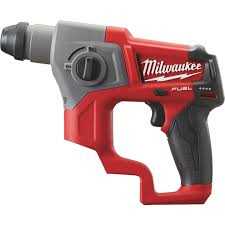
Before operating a rotary hammer drill, it is essential to wear the appropriate protective gear to prevent injuries. This includes:
- Safety goggles to protect your eyes from flying debris.
- Ear muffs or earplugs to protect your hearing from the loud noise produced by the drill.
- Work gloves to provide protection and improve grip.
- A dust mask or respirator to prevent inhalation of harmful dust particles.
- Appropriate footwear for better stability and to protect your feet from falling objects.
2. Secure the Workpiece
Prior to using the rotary hammer drill, it is important to ensure that the workpiece is properly secured. This will prevent it from moving or slipping during operation, which can cause accidents or injuries.
3. Inspect the Drill
Before using the rotary hammer drill, thoroughly inspect it to ensure that it is in good working condition. Check for any loose or damaged parts, such as the chuck, handle, or power cord. Do not use a drill that appears to be damaged or faulty.
4. Use the Correct Bit
Always use the proper drill bit for the specific task you are performing. Using the wrong bit can result in accidents or damage to the drill or workpiece. Refer to the manufacturer’s instructions or consult a professional for guidance on selecting the appropriate drill bit.
5. Familiarize Yourself with the Controls
Before operating the rotary hammer drill, take the time to familiarize yourself with the location and function of the various controls. This includes the power switch, speed control, and any additional features specific to your drill model. Understanding how to properly operate the drill will help prevent accidents and ensure efficient and safe use.
6. Maintain a Stable Stance
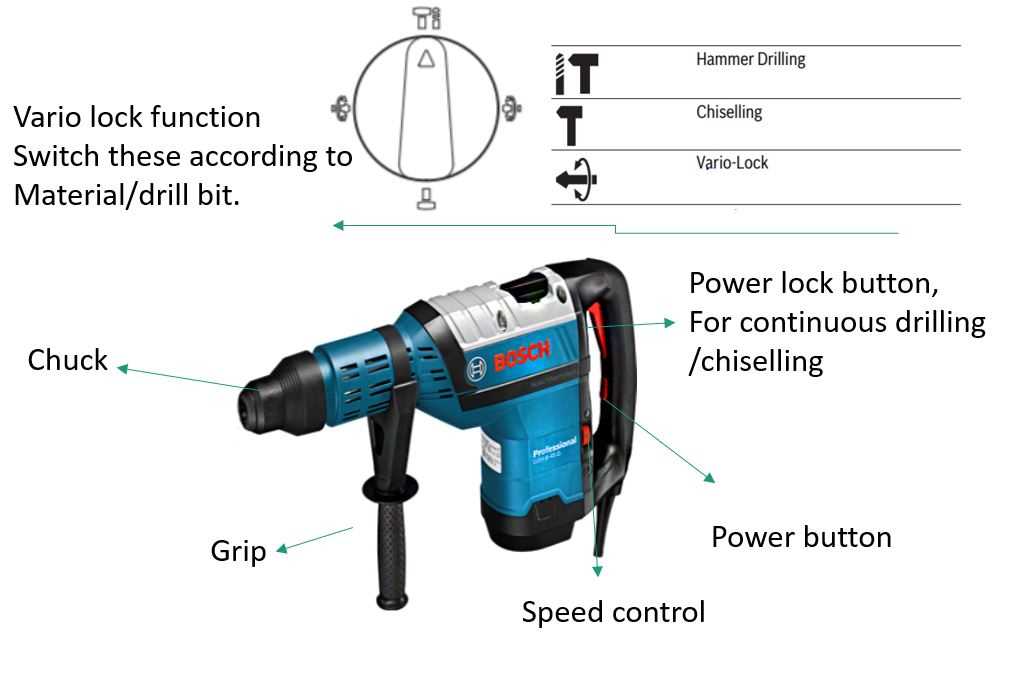
When operating the rotary hammer drill, maintain a stable stance with feet shoulder-width apart. This will provide better balance and control, reducing the risk of accidents or injuries. Avoid standing on ladders or unstable surfaces while using the drill.
7. Use Proper Technique
When using the rotary hammer drill, apply steady and even pressure. Avoid excessive force or angling the drill in a way that may cause it to bind or kickback. This will help ensure precise and safe drilling.
8. Take Breaks
Rotary hammer drilling can be physically demanding. Take regular breaks to avoid fatigue, which can lead to decreased focus and increased risk of accidents.
9. Store Properly
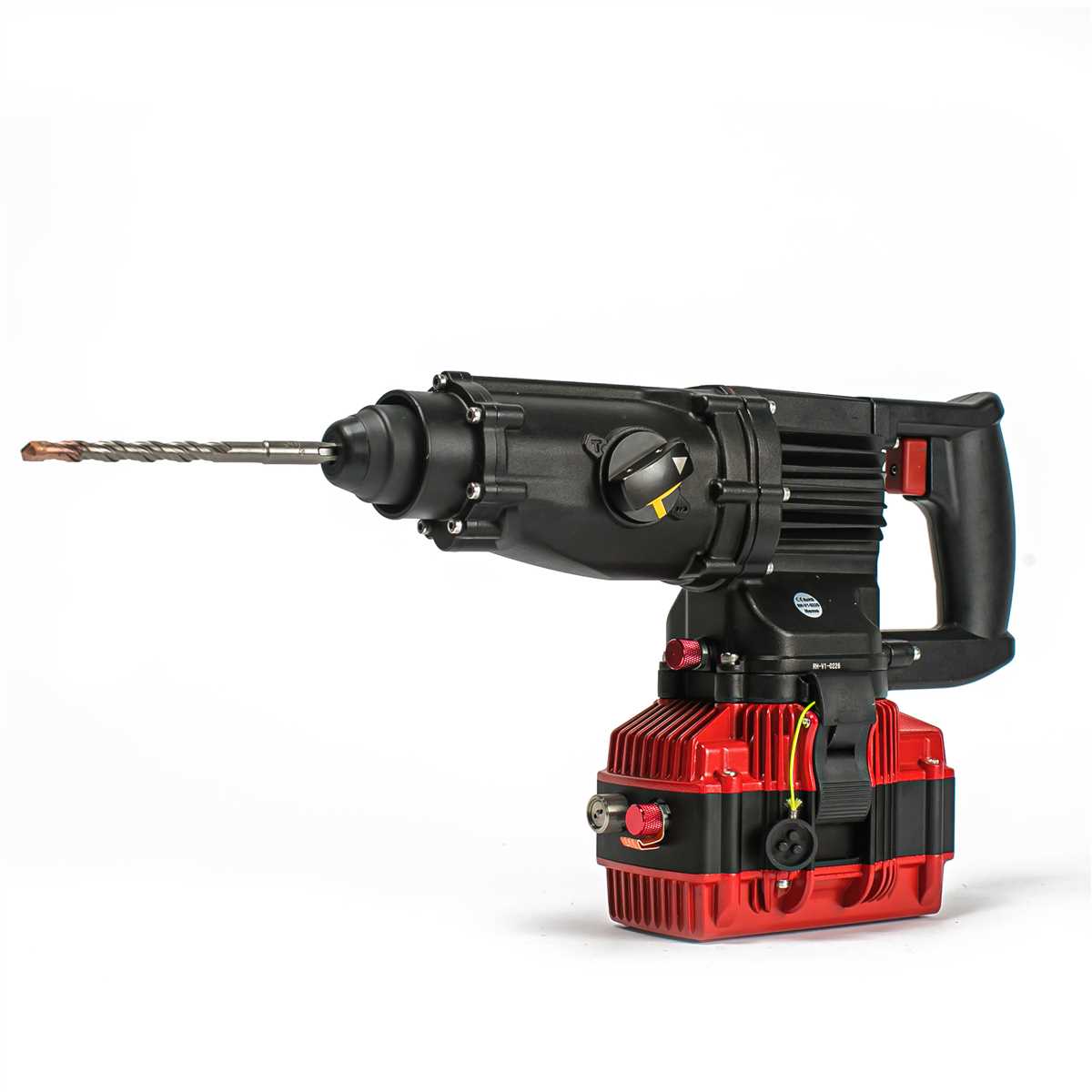
After use, store the rotary hammer drill in a safe and secure location, out of reach of children and pets. Ensure that the power cord is neatly coiled and that the drill is protected from moisture and extreme temperatures. Additionally, follow all manufacturer recommendations for storage and maintenance.
Types of Materials Suitable for Drilling
Rotary hammer drills can be used to drill into various types of materials. The suitability of a material for drilling depends on its hardness and composition. Here are some common materials that can be drilled using a rotary hammer drill:
1. Concrete
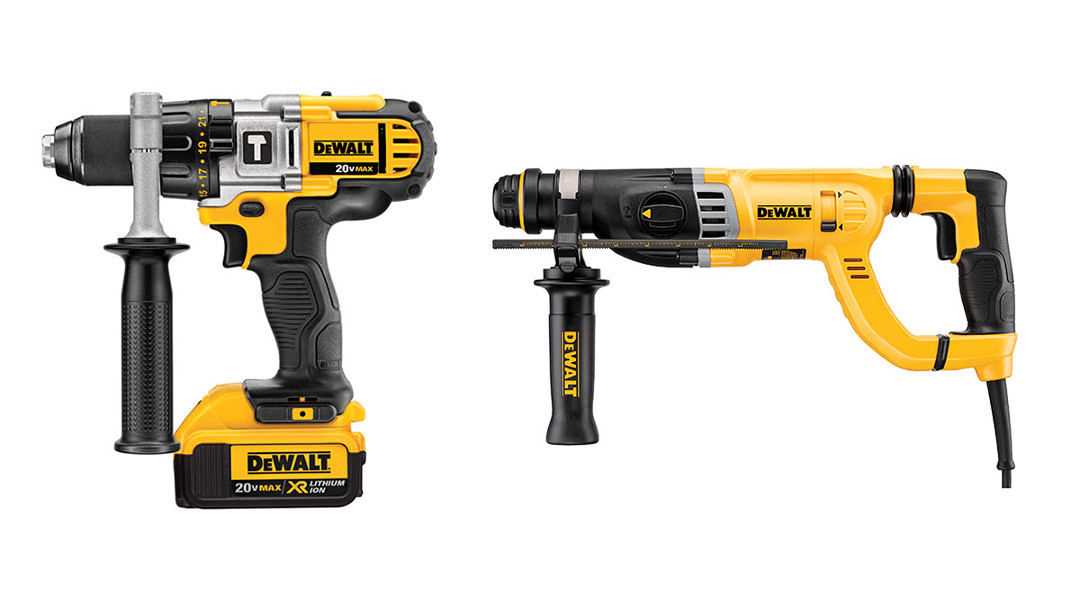
Concrete is one of the most commonly drilled materials using a rotary hammer drill. These drills are designed to efficiently drill holes in concrete surfaces. The rotary motion combined with the hammering action helps to break through the concrete and create clean and precise holes.
2. Brick
Brick is another material that can be effectively drilled using a rotary hammer drill. While brick is not as hard as concrete, the hammering action of the drill helps to break through the brick and create holes.
3. Stone
Stone surfaces, such as granite or marble, can also be drilled using a rotary hammer drill. However, drilling into stone requires proper technique and the use of appropriate drill bits. It is important to choose the right drill bit that is specifically designed for drilling into stone.
4. Wood
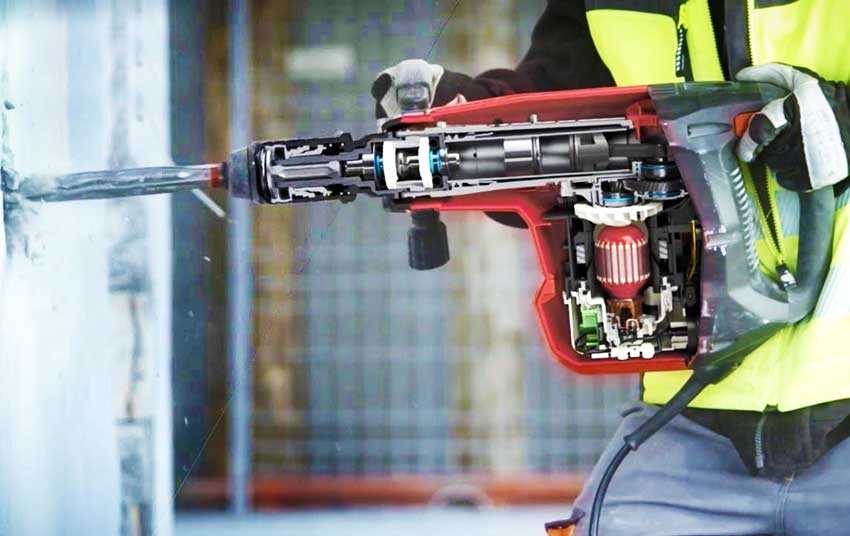
Although rotary hammer drills are primarily designed for drilling into hard materials like concrete, they can also be used to drill into wood. However, it is important to note that rotary hammer drills are not the most efficient tool for drilling into wood. For drilling wood, it is recommended to use a regular drill or a drill press.
5. Metal
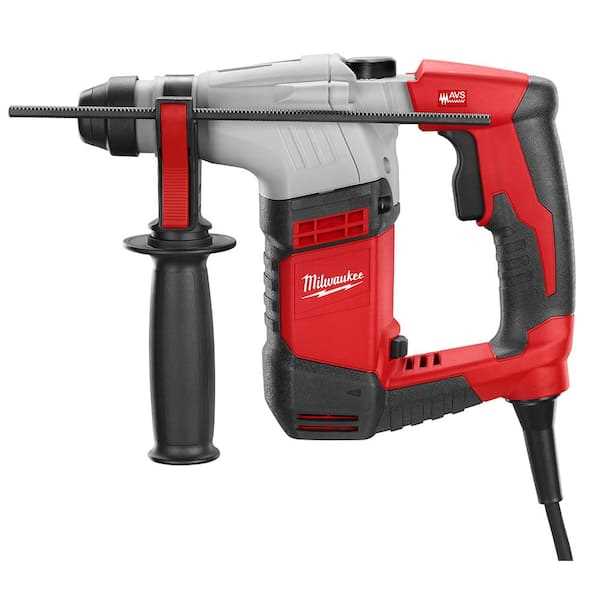
Rotary hammer drills are not typically used for drilling into metal. Metal requires a different type of drill bit and drilling technique. For drilling into metal, it is recommended to use a drill press or a regular drill with appropriate metal drill bits.
Overall, rotary hammer drills are versatile tools that can be used for drilling into a variety of materials. However, it is important to choose the right drill bit and use proper technique based on the material being drilled for the best results.
Choosing the Right Drill Bits
When it comes to using a rotary hammer drill, choosing the right drill bits is crucial for achieving the desired results. Different drill bits are designed for specific materials and applications, so it’s important to select the appropriate ones based on your project requirements. Here are some factors to consider when choosing drill bits for your rotary hammer drill:
Material Compatibility
The first thing to consider is the material you will be drilling into. Different drill bits are designed to handle specific materials such as concrete, masonry, wood, metal, or tile. Ensure that the drill bits you choose are compatible with the material you will be working on to achieve optimal results. Using the wrong drill bits can not only damage the material but also result in ineffective drilling.
Drill Bit Type
There are several types of drill bits available for rotary hammer drills, each designed for specific applications:
- Masonry Drill Bits: These drill bits are specially designed for drilling into concrete, brick, or other masonry materials. They typically have a carbide tip for increased durability and feature a fluted design for efficient dust removal.
- Wood Drill Bits: These drill bits are designed for drilling into wood and often feature a pointed tip or spade-shaped cutting edge. They are available in various sizes and can be used for both rough and fine drilling tasks.
- Metal Drill Bits: These drill bits are specifically designed for drilling through metal surfaces. They are made of high-speed steel (HSS) or cobalt and have a sharp, pointed tip for precise drilling.
- Tile Drill Bits: These drill bits are designed for drilling into ceramic, porcelain, or glass tiles. They have a specialized carbide tip that allows for clean and precise drilling without damaging the fragile tile surface.
Size and Shape
Drill bits come in various sizes and shapes, and choosing the right size is essential for achieving the desired hole diameter. Most drill bits are labeled with their size in inches or millimeters. Additionally, consider the shape of the drill bit’s shank, as it should match the chuck size of your rotary hammer drill.
Quality and Durability
Investing in high-quality drill bits is important for ensuring their durability and longevity. Low-quality drill bits can wear out quickly and result in poor drilling performance. Look for drill bits made from high-quality materials and featuring a solid construction.
Safety Considerations
Always prioritize safety when working with a rotary hammer drill. Make sure to wear proper safety gear, including goggles, gloves, and ear protection. Additionally, follow the manufacturer’s recommendations and guidelines for operating the drill and using the drill bits.
By considering these factors when choosing drill bits for your rotary hammer drill, you can ensure efficient and accurate drilling for your projects. Remember to always select the right drill bits for the specific material and application to achieve the best results.
Maintenance and Longevity
Regular Maintenance
Proper maintenance is essential to ensure the longevity and optimal performance of a rotary hammer drill. Here are some key maintenance tips:
- Cleaning: After each use, make sure to clean the drill thoroughly. Remove any dust, debris, or residue from the drill body, chuck, and drill bits. Use a brush or compressed air to clean hard-to-reach areas.
- Lubrication: Apply lubricating oil to the drill’s moving parts, such as the chuck and gears, as recommended by the manufacturer. This helps to reduce friction, prevent rust, and ensure smooth operation.
- Inspecting: Regularly inspect the drill for any signs of wear, damage, or loose parts. Check the cords and plugs for any fraying or exposed wires. If any issues are found, repair or replace the affected parts immediately.
- Battery Care: If using a cordless rotary hammer drill, follow the manufacturer’s guidelines for charging and maintaining the battery. Avoid overcharging or discharging the battery completely, as this can reduce its lifespan.
Storage
Proper storage is also crucial for maintaining the longevity of a rotary hammer drill. Follow these storage tips:
- Clean and Dry: Before storing the drill, ensure that it is clean and dry. Remove any dust or debris and wipe down the exterior with a damp cloth.
- Protected Environment: Store the drill in a dry and temperature-controlled environment, away from moisture or extreme temperatures. This helps to prevent rust and damage to the internal components.
- Secure Storage: Keep the drill in a secure location where it is protected from accidental knocks or falls. Consider using a storage case or cabinet specifically designed for power tools.
Professional Servicing
While regular maintenance can go a long way in ensuring the longevity of a rotary hammer drill, certain issues may require professional servicing. If the drill is experiencing persistent performance issues, unusual sounds, or mechanical problems, it is recommended to contact a qualified repair technician.
Longevity and Replacement
The lifespan of a rotary hammer drill can vary depending on factors such as frequency of use, maintenance practices, and the quality of the drill itself. With proper care and regular maintenance, a rotary hammer drill can last for many years. However, if the drill becomes extensively worn or damaged and repairs are uneconomical, it may be time to consider replacing it.
When purchasing a new rotary hammer drill, consider factors such as power, durability, and warranty coverage to ensure you choose a drill that will meet your needs and have a long lifespan.
FAQ:
What is a rotary hammer drill?
A rotary hammer drill is a powerful tool used for drilling holes in tough materials such as concrete, brick, and stone. It combines a hammering action with a rotating motion, allowing it to easily break through hard surfaces.
How does a rotary hammer drill work?
A rotary hammer drill works by using a piston mechanism to deliver a high impact force to the bit. When the user presses the drill against a surface and pulls the trigger, the piston moves back and forth, striking the back of the bit with a hammering action while simultaneously rotating it. This combination of impact and rotation makes drilling through tough materials much easier and faster.
What are the advantages of using a rotary hammer drill over a regular drill?
There are several advantages of using a rotary hammer drill over a regular drill. Firstly, the hammering action of the rotary hammer drill allows it to easily break through hard materials without getting stuck. Regular drills, on the other hand, tend to get jammed when drilling into tough surfaces. Additionally, rotary hammer drills are more powerful and efficient, making them suitable for heavy-duty applications. Finally, rotary hammer drills usually have a variety of settings and modes, allowing the user to switch between drilling, hammering, and chiseling, depending on the task at hand.
Can a rotary hammer drill be used for other tasks besides drilling holes?
Yes, a rotary hammer drill can be used for other tasks besides drilling holes. Many rotary hammer drills come with additional functions such as hammering and chiseling, which allow them to be used for tasks such as removing tiles, breaking up concrete, and creating channels for pipes and cables. The versatility of the rotary hammer drill makes it a valuable tool for construction and renovation projects.
What are the different types of rotary hammer drills available?
There are several types of rotary hammer drills available in the market. The most common types include corded rotary hammer drills, which require a power outlet for operation, and cordless rotary hammer drills, which run on rechargeable batteries. Additionally, there are different sizes and power levels of rotary hammer drills, ranging from small and lightweight models for DIY projects to larger and more powerful models for professional use.
Are there any safety precautions to consider when using a rotary hammer drill?
Yes, there are some safety precautions to consider when using a rotary hammer drill. Firstly, it is important to wear protective gear such as safety goggles and earplugs to prevent injury from flying debris and loud noises. It is also advisable to secure any loose clothing and tie back long hair to avoid it getting caught in the drill. Additionally, proper grip and control of the drill should be maintained at all times to prevent accidents. Finally, it is important to read and follow the manufacturer’s instructions and guidelines for safe and proper use of the rotary hammer drill.
Video:











